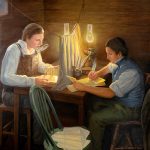| Louis Agassiz | |
|---|---|
 | |
| Born | May 28, 1807(1807-05-28) Haut-Vully, Switzerland |
| Died | December 14, 1873(1873-12-14) (aged 66) Cambridge, Massachusetts, USA |
| Spouse | Cecile Braun Elizabeth Cabot Cary |
| Father | Rodolphe Agassiz |
| Mother | Rose Mayor Agassiz |
| Signature |  |
Associated Locations:
- Haut-Vully, Switzerland
Associated Dates:
- May 28, 1807 – Born
Louis Agassiz is one of the eminent spirits who appeared to President Wilford Woodruff in the St. George Temple (Latter-day Saint, LDS) on August 21, 1877. This interesting story is detailed in the Eminent Spirits Appear to Wilford Woodruff wiki.
Life Sketch from The Other Eminent Men of Wilford Woodruff
Copyright © Taken from the book: The Other Eminent Men of Wilford Woodruff. Special thanks to Vicki Jo Anderson. Please do not copy.
Swiss-American Naturalist 1807-1873
The greatest natural scientist of the eighteenth century, Louis Agassiz is acknowledged even by current researchers as the greatest natural scientist of his day.
1He established the Ice Age and thus became known as the “Father of the Ice Age.” A noted teacher, Agassiz attracted students from all over the world. His legacy was the comparative method. He established the famous Museum of Comparative Anatomy at Harvard University, and he and his wife established Radcliffe, the great women’s institution of higher education.
“It is the job of prophets and scientists alike to proclaim the glories of God.”
– Louis Agassiz
Agassiz’s Acomplishments
Although contemporaries of Agassiz and even researchers of today proclaim him as the greatest natural scientists of his day,
2little is known of this great man today. Charles Darwin, one of Agassiz’s later contemporaries, on meeting the poet Henry W. Longfellow, said: “What set of men you have in Cambridge! Why, there is Agassiz–he counts for three.”
3Darwin should know–for it was the great work done by Agassiz in entomology that Darwin used in is formulation of his Origin of Species.
Apparently, Agassiz and his defense of creation were in some way blackballed from the scientific and historical community while Darwin’s theories have remained. However, it was not from Agassiz’s lack of scholarship or impact upon the world. All evidence points towards Agassiz being ignored because he tenaciously held that nature was a result of divine thought, “the free conception of the Almighty Intellect, matured in his thought, before it was manifested in tangible external forms.”
4For Agassiz to discover the structure of nature was to engage our brain with thought similar to our Creator’s: “In our study of natural objects we are approaching the thoughts of the creator, reading his conceptions, interpreting a system that is His and not ours.”
5Darwin, on the other hand, ventured where Agassiz refused to go. Darwin “overstepped the boundaries of actual knowledge and allowed his imagination to supply the links which science does not furnish.”
6This Agassiz steadfastly refused to do. He stated: “A physical fact is as sacred as a moral principle. Our own nature demands from us this double allegiance.”
7Agassiz saw too well how a scientist who didn’t pay especial care to the facts could easily make the jump from the development of embryonic fish to evolutionized man. However, early in his fossil succession shows us that the lowest in structure is by no means necessarily the earliest in time.”
8This is particularly true of the shark family. Anatomically evolution looked sound, but geologically it just couldn’t work. The mere existence of the well developed shark (Selachians) family is a direct contradiction to the idea of a gradual (evolutionary) development because the sharks are found abundantly in the earliest of the Palaeozoic fossil beds!
Agassiz believed that “facts are the words of God, and we may heap them together endlessly, but they will teach us little or nothing till we place them in their true relations, and recognize the thought that binds them together.”
9To Agassiz this process of binding facts together was nature’s claim to “Divine Conception.” Every fact in nature was sacred to him. Even as a child Agassiz felt that God’s revelations of Himself were not limited to the writings in the Bible–God also revealed himself through the book of Nature.
Agassiz’ Mother
Agassiz’s ancestors were French Hugunots who had escaped from France during the persecution of Louis XIV. For the previous five generation, his ancestors, including his father, had been clergyman. His mother came from an intellectual and sturdy stock. Born 28 May 1807, in Motier, a Swiss village nestled on the shore of Lake Morat at the foot of the Bernese Alps, Louis John Rudolph Agassiz was blessed with loving parents. They were his only teachers until he was ten years old and they did not try to push him beyond the ordinary achievements for his age. His mother lost her first four children in infancy. Perhaps it was for this reason that she was so close to Louis. She understood his love of nature and all living things. She recognized he had intellectual tendencies and more than a child’s normal delight with animals. It appears that early in his life she had been granted an understanding of the great work he had destined to do. This knowledge gave her the position of being his most intimate friend even up to the last hour of her life.10
The close relationship Agassiz had with his mother gave him a high opinion of women. He humorously based his Ph.D. thesis “on the argument that women, being historically the later creature, was an improvement upon man,” indicating his humorous approach to life.11 During his years at Harvard in an age when women were mostly shut out from higher education he supported equal access to education for women. He also employed women as assistants in establishing his several museums.12
Marriage
Agassiz married twice, each time to an unusual and gifted women. His first wife, Cecile Braun, had an wonderful talent fr drawing and sketching. Her talent was very important in Agassiz work on fossils. After Cecile died, he married Elizabeth Cabot Cary, who was noted for her literacy and executive ability. Elizabeth’s organizational ability was a great aid to his career in America. To help support the tremendous cost of Agassiz’s extensive research projects, Elizabeth, with the help of Agassiz’s two daughters, Ida and Paulene, suggested the idea of beginning a girls boarding school with Agassiz as the main attraction.
He loved the idea of a women’s school, and they immediately went to work on it. Agassiz enlisted some of his fellow professors and student assistant s at Harvard to come and teach the girls. The school was tremendously successful but had to close during the Civil War. It was reopened years later under the executive ability of Elizabeth and grew into the now famous Radcliffe University. 13
As a teenager he convinced his sister Cecilia to draw for him any new species of fish he found. She cooperated willingly by doing his sketch work. At fourteen it was the modest aim of Louis, with the help of a brother, to memorize the Latin names of “every known animal and plant!”
14Early Life
As a child, Louis also loved to collect things. His parents tolerated much of his valuable “junk,” collected and stored in his and his brother Augustus; bedroom. Their yard was alive with animals. They ranged from the family cow and horse to mice, birds, and snakes. Agassiz loved and tenderly cared for each one.
Although Agassiz dislike leaving all his prize possessions, at the age of ten he, along with his brother Augustus, attended a boarding school at the college de Bienne in a town some twenty miles away. After leaving de Bienne he attended the Academy at Lusanne and entered medical school at Zurich. From there he attended Heidelberg and finished at the University of Munich where he received his M.D.
However, Louis studied medicine only to obey his father; his first love was the study of nature, or Zoology as it is commonly called today. With his roommate, Alexander Braun (brother of his wife-to-be Cecile), they formed their own “little academy.” With their friends, they sat for hours each evening debating the problems of the universe. Included in this gorup were many of the later great scientists of Europe. Agassiz would later reflect that “all our members increas[d] their knowledge by sharing.” 15
Under a philosophy professor named Schelling, Louis’s faith broadened to a less dogmatic but not a less deep belief in God. Professor Schelling helped instill in Agassiz a growing conviction that the diversity of animal forms could be explained as individual thoughts of the Creator. 16
As Agassiz approached his graduation as an M.D., he was dismayed by the thought of losing the opportunity for research he had at the university. He was already well known for his work on the fish of Brazil, a work gathered by botanist Von Martius and J. P. Spix. The latter died before the work could be compiled and published, leaving Agassiz to classify and published the data. The book was written with beauty and clarity showing that Agassiz would become not only a man of science but also a man of letters. In this one project alone he characterized “nine new genera, embracing forty-two species new to science.”17 By the time of his graduation he had written more than seventy-five theses on anatomy, surgery, obstertrics, and pathology.
Cuvier, Humboldt
Shortly after graduation he went to Paris with a small sum of money loaned to him by a kindly uncle. Here he took residence in a small apartment across from the famous Jardin des Plantes, the center of Natural History for all of Europe. The headmaster, Professor Georges Cuvier, the leading savant in France and master of comparative anatomy, accepted Agassiz with open arms. It was Cuvier who first established the basis of our classification system with its four branches: the Radiatas, Mollusks, Articulata, and Vertebrata. Cuvier classified these groups according to their anatomical structure, not their function.
18This means of classification Agassiz felt demonstrated that Nature was the work of a “reflective mind,” as in the oldest geological formations these four branches of the animal kingdom had always existed simultaneously.
Agassiz prospered intellectually under Cuvier. His one great wish was to help him prepare a book on fossilized fishes. His dream was more than realized: the grateful Cuvier turned the entire collection over to Agassiz and told him to go ahead with the book.
“I work regularly fifteen hours a day,” he wrote his parents. He continued this work though he was short on money, often skipping meals to get by. Cuvier, pleaded with him to relax from his research. “Be careful, and remember that work kills,” he warned the young man. Cuvier knew whereof he spoke, for shortly after his warning to Agassiz, he was himself stricken with a paralysis and died.19 His death deeply affected his young apprentice, but instead of sinking in grief Agassiz became the champion of Cuvier’s views that nature came about by a “Divine Intelligence.” Agassiz never departed from that true principle.
The great patron of all sciences, Alexander von Humboldt, befriended the struggling young scientist and loaned him 1,000 francs. This was the first time Dr. Humboldt sponsored Agassiz. Von Humboldt also used his influence to obtain a professorship for Agassiz at the University of Neuchatel at the foot of the Aar Mountains in Switzerland. This allowed Agassiz to return to his beloved Switzerland. With the patronage of von Humboldt and through th magic of his personality and talent, Agassiz transformed Neuchatel into one of the great centers of science in Europe. 20
Teaching Science
He looked upon his students more as co-workers than subordinates. He enjoyed firing their imagination as they hiked through hills and fields. He continually talked to them of the marvelous works of God as they walked without a textbook. He taught a living science: “If you study nature in books, when you go out of doors you cannot find her.” 21
A student, Clara Conant Gilson, described him in this way: “His eyes … would moisten with tears of emotion as thoughts of his Creator came rushing to mind, while he traced his [the creator’s] footsteps in the science he studied. His eyes mirrored his soul. I think there was never but one pair of eyes such as Professor Louis Agassiz.” 22 He was easily moved to tears or to laughter and made no attempts to hide his feelings.
His summer curriculum, in contrast to his winter curriculum, was always out of doors. He taught his young colleagues the basics of geography by climbing with them and pointing out the vast panorama below. For him, “Geology [was] but an extension of Zoology.”23
He wanted students to depend on natural objects rather than on statements in books. He drummed his students constantly with “Look, look; to look is to know.”24 “Go to nature; take the facts into your own hands; look, and see for yourself.” 25
His winter curriculum consisted of placing a specimen, often a smelly picked fish on a student’s desk in a small tin pan. Write down everything they could see, he would tell them before leaving them to “discover.” Their only tool was a pencil: “A pencil is one of the best of eyes,” he said.26 The students were instructed to point out similarities and differences. In this way the students gained knowledge that was “theirs”; it could never be taken away. “The mind is made strong not through much learning, but by the thorough possession of something, “Agassiz said. 27
In order to gain a general view of science, Agassiz recommended that his students study its history. His advice to his future teachers was to “select subjects that your pupils cannot walk by without seeing them.” He said, “Train your pupils to be observers and have them provided with the specimens about which you speak. If you can find nothing better, take a house-fly or a cricket, and let each hold a specimen and examine it as you talk. 28
Agassiz’s particular strength was his research. It is not surprising that at Neuchatel, nestled in the beautiful Swiss Alps, he turned from fossils to glaciers. He spent his summers studying glaciers; living, working, and sleeping on one. Once he ever convinced his co-workers to lover him in a crevasse, to the depth of eighty feet, where he nearly lost his life in an icy underground river.
29From this research he startled savants of his time with the knowledge that glaciers actually moved.
He went on to advance the theory that Europe at one stage had been completely covered by a solid sheet of ice. He announced this study at the annual meeting of the leading scientists of his day, the Helvetic Society, of which he was president. His presentation was seen as a disaster, and the audience actually booed. Even his mentor, von Humboldt, appeared disappointed. Von Humboldt recommended to young Agassiz that he have all the research and available facts before announcing such a bold new theory. Agassiz was more than happy to accepts such good advice. He spent next year in intense research establishing the proof that there had been an “Ice Age” and eventually became known as the father of the “Ice Age.”
Sent to America
Alexander von Humboldt procured the patronage of the King of Prussia for Agassiz in 1846, who sent Agassiz to America to study the zoology of the United States in order to compare it to that of Europe. While in the States he was commissioned to lecture at the Lowell Institute of Boston. His first lecture, to a crowd of 1500, was “God’s Planned Creation.” Agassiz was deeply touched by the sight of rich and poor seated side by side in a country where individuals had freedom to advance equally in education.
He quickly developed an immense liking for the country and a passionate belief in its future. When his wife Cecile passed away, and even that considerably loosened his ties with his mother land, Agassiz remarried and brought his children to America. Although considerable effort was made to lure him back to Europe–not only by the King of Prussia, but even by the Emperor Napoleon III who offered him a distinguished post at the Jardin des Plantes–nothing could entice him to leave his new-found country. “I’ve decided,” Agassiz told his wife, Elizabeth, “that I prefer the figst of a free people to the patronage of an emperor.”30 So strong was his belief in the future of this country that although this was in the darkest hours of the Civil War, Agassiz chose nevertheless to become a citizen of the United States and a founder of the National Academy of Science. 31 He was also influential in establishing the Natural History museum in the Smithsonian Institute.
The moment of his arrival in the New World Was particularly fortunate and well timed. Before this time, American had been conscentrating her efforts and resources primarily in the building of a new nation. American was just beginning to build up her arts and sciences. Agassiz, having read the scientific compilations of America, found them to be generally “not of good execution.” His first order of business was to set out for Washington, D.C. (unannounced, in 1846), and help the government set strict criteria for good scientific work and publications.32 Many of America’s scientific advancements owe their progress to the groundwork Agassiz set and his consistent demand for quality.
Agassiz’s Lectures, Essays, Books
Through lecture and essay, Agassiz spent the closing fifteen years of his life defending “creation.” The two most direct and complete works Agassiz produced at this time were Essays on Classification and Evolution and Permanence Type. (Another excellent publication by Agassiz is Methods of Study in Natural History).
His defense of Nature’s law and Nature’s God places him preeminently among the “interpreters of Nature’s Divine Conception.” Agassiz himself [aced the divisions of the animal kingdom as chapter headings in nature’s great book that leads man to know God. According to Agassiz the act of translating the “thoughts of God” is the most conclusive proof of our affinity with the Divine Mind. He reasoned: “Is not this intellectual and spiritual connection with the Almighty worth out deepest consideration? 33 While Agassiz’s death brought to end a tradition of though scientifically initiated by Aristotle–that of “divine creation,” his research has shown that it can endure the test of time. His stand on divine creation is as valid and compelling today as it was in his.
34Character Traits
Discredited Because of Belief in Creation
Apparently, Agassiz and his defense of creation were in some way blackballed from the scientific and historical community while Darwin’s theories have remained. However, it was not from Agassiz’s lack of scholarship or impact upon the world. All evidence points towards Agassiz being ignored because he tenaciously held that nature was a result of divine thought, “the free conception of the Almighty Intellect, matured in his thought, before it was manifested in tangible external forms.” For Agassiz, to discover the structure of nature was to engage our brain with though similar to the Creator’s: “In our study of natural objects we are approaching the thoughts of the Creator, reading his conceptions interpreting a system that is His and not ours.”
35Inspiring Stories
Inspiration for Discoveries
Agassiz considered himself to be the “librarian of the works of God.”36 In his records he tells of his unsuccessful efforts to classify a fossil fish partly concealed in a mass of stone. Then for three consecutive nights he had a “dream” in which the characteristics of the fish were shown to him. After the third night Agassiz was able to draw what he had seen in the dream. Using the sketch, the next day he was able to cut away the stone enclosing the fossil, disclosing a fossil hitherto unknown.37 This occasion led to the modern sciences of icthiology. Geology and paleontology also bear the stamp of his contributions.39
- See Gould, Stephen Jay, “Agassiz in the Galapagos,” Natural History, vol. 90, no. 12 (12 Dec. 1981). See also Lane Cooper’s Louis Agassiz as a Teacher: Illustrative Extracts on His Method of Instruction. Ithaca, New York: Comstock Publishing, 1945, p. 8.
- See Marcou, Jules. Life, Letters, and Works of Louis Agassiz. New York: Macmillan and Co., 1896, p. 169.
- Magill, Frank. Great Lives from History. Pasadena, Calif.: Salem Press, 1987, p. 44-45
- Agassiz, Louis. “An Essay on Classification” as compiled in The Intelligence of Agassiz by Guy Davenport. Westport, Conn.; Greenwood Press, 1983. Reprint permission by Beacon Press, Boston 1963, p.38.
- Agassiz, Louis. Methods of Study in Natural History. Boston: Ticknor and Fields, 1863, p. 14.
- Marcou, Life, Letters, and Works of Louis Agassiz, p. 209.
- Agassiz, Elizabeth. Louis Agassiz: His Life and Correspondence. Boston: Houghton, Mifflin, 1885, 3:781.
- Agassiz, Louis, Methods of Study, p. 202.
- Agassiz, Louis, “Evolution and Permanence Type” as compiled in Davenport’s The Intelligence of Agassiz, p. 231
- See Agassiz, Elizabeth, 1:2-3.
- See Cooper, p. 11
- See ibid.
- See Agassiz, Elizabeth, 2:526-27
- Thomas, Henry, and Dana Lee Thomas. Living Biographies: Great Scientists. New York: Nelson Doubleday, 1941, p. 167
- Thomas, and Thomas, p. 169
- See Cooper, p. 14
- Ibid., p. 16.
- See Agassiz, Louis, Methods of Study, p. 7-9
- Agassiz, Elizabeth, 1:168
- See Thomas and Thomas, p. 173
- Cooper, p. 78
- Ibid., p. 72
- Thomas and Thomas, p. 175
- Ibid., p. 182.
- Cooper, p.78
- Ibid., p. 58
- Ibid., p. 81
- Ibid., p. 82
- See Tiner, John H, The Ghost Lake: The True Story of Louis Agassiz. Grand Rapids, Mich.: Baker Book House, 1983, p. 69-70
- Agassiz, Elizabeth, p. 163
- See Cooper, p. 25
- See Marcou, p.287-88
- Agassiz, Louis, “An Essay on Classification,” p. 37
- Used with permission: Anderson, Vicki Jo. The Other Eminent Men of Wilford Woodruff. Zichron Historical Research Institute. Cottonwood, AZ 86326
- Used with permission: Anderson, Vicki Jo. The Other Eminent Men of Wilford Woodruff. Zichron Historical Research Institute. Cottonwood, AZ 86326
- Agassiz, Louis, “An Essay on Classification,” p. 3
- See Agassiz, Elizabeth 1:182-83
- Copyright © Taken from the book: The Other Eminent Men of Wilford Woodruff. Special thanks to Vicki Jo Anderson. Please do not copy. 38Anderson, Vicki Jo. (1994). The Other Eminent Men of Wilford Woodruff. Cottonwood, AZ: Zichron Historical Research Institute.







